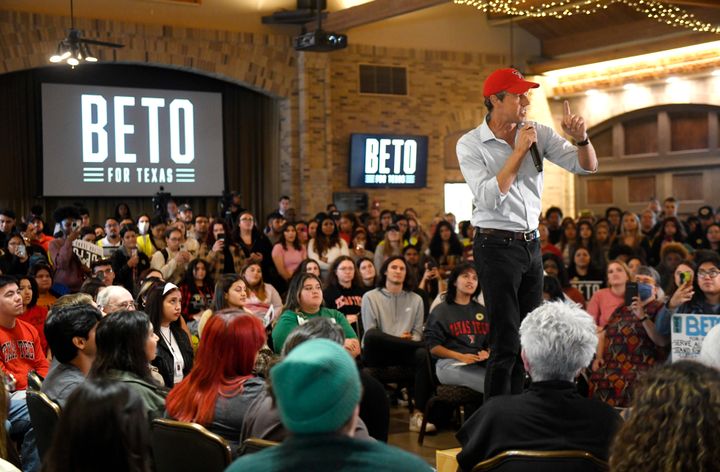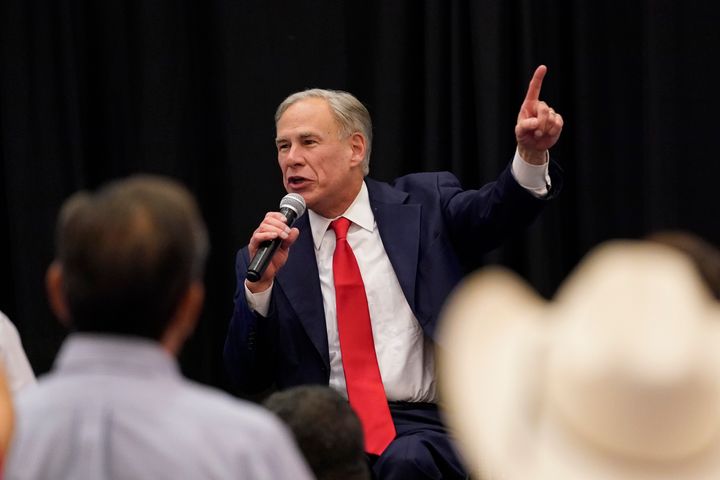
EL PASO, Texas – Isabel Orozco, a nursing student at the University of Texas, El Paso, was among the undergraduates who braved the hourlong selfie line after Beto O’Rourke’s rally on campus. The timing of one of her classes prevented her from attending the rally, but she arrived afterward clutching a black-and-white “Beto” placard for him to sign.
A first-time voter, Orozco said she admired O’Rourke’s willingness to confront Texas Gov. Greg Abbott (R) at a news conference the day after the mass shooting at an elementary school in Uvalde in May.
“Thinking about the shooting is really scary and I know he’s going to make some good changes,” Orozco said, referring to O’Rourke’s support for stricter gun laws.
Unlike next month’s elections in Pennsylvania, Georgia, and even neighboring New Mexico, the race for governor of Texas has not received major national attention — or resources — this cycle.
Conventional wisdom in the national organs of both major parties ― backed by virtually every public poll ― has it that Abbott, while weaker than in the past, is the prohibitive favorite for a third term as leader of the Lone Star State.
Although even O’Rourke’s closest backers acknowledge the difficulty of toppling the incumbent, they believe his path runs through new voters like Orozco, and infrequent voters who don’t normally turn out.
“It’s all these [nonwhite] young people who look like me that are aging into the process and changing the state,” said Sri Preston Kulkarni, a former Houston-area congressional candidate now running Two Million Texans, a Democratic get-out-the-vote operation that uses personal networks to target low-propensity voters. “If we vote in our true numbers across the state, Republicans are done.”

Analysts who argue that Democrats can rely on organic demographic change and increases in turnout to win elections, rather than the more ideologically challenging work of winning over swing voters who toggle between the two major parties, have endured more scrutiny since 2020. Critics of the theory note that increased turnout in the 2020 presidential election and the 2021 Virginia gubernatorial election appears to have been, at best, net-neutral for Democrats.
But Kulkarni and other advocates of a turnout-based strategy argue that Texas’ famously low voter participation rate leaves more room for improvement than might be the case in other states. Just 42% of eligible Texas voters cast ballots in the 2018 midterm elections. And that was a massive increase over the 25% participation rate in the 2014 midterms.
If anyone can repeat the 2018 increase in turnout, it’s O’Rourke, whose Senate campaign drove Democratic enthusiasm up and down the ballot four years ago, according to his allies. O’Rourke fell short that year. But thanks in part to the turnout his campaign generated, the party flipped two U.S. House seats, two state Senate seats, and 11 state House seats.
“Beto has been the campfire that Democrats have huddled around no matter what part of the state they were in,” said Colin Strother, a veteran strategist for moderate Texas Democrats. “He went places that no Democrat has been in generations. He gave people hope and a reason to believe.”
In addition, the young, low-propensity voters that Kulkarni references — and O’Rourke is courting — are likely being undercounted in the public polls showing Abbott with a high single-digit lead, posited Gilberto Hinojosa, who chairs the Texas Democratic Party.
Polls try to project outcomes based on a model universe of “likely voters,” but newer and less frequent voters are, by definition, harder to account for, according to Hinojosa.
In 2018, when O’Rourke ran for Senate, he held Sen. Ted Cruz (R) to 2.6 percentage points, despite a number of pre-election polls showing Cruz ahead by much larger margins, Hinojosa noted. (Some pre-election polls came close to predicting that outcome, however.)
O’Rourke’s rally in El Paso, his home city, on Tuesday night was the final stop in a tour of 12 college campuses across the state. Earlier in the day, O’Rourke addressed over 850 attendees at a rally on the Texas Tech campus in Lubbock, after which he and his team drove five and a half hours to El Paso.
“He’s done more college campuses than I’ve ever seen done by any statewide candidate in Texas,” Hinojosa said.
Polls be damned, Hinojosa insisted, O’Rourke’s bid for governor is “every bit as magical” as his Senate race in 2018.
“We don’t want to judge or blame anyone for choosing Abbott in the past. I think that may have been for many a very rational decision.”
- Beto O'Rourke
In fact, O’Rourke’s field operation in general, and his plan for registering voters and driving up turnout on college campuses in particular, is considerably more sophisticated than it was in his Senate run.
For the first time this cycle, O’Rourke’s campaign has teams of organizers and student volunteers on 50 campuses across the state.
By the time he shows up at a college for a rally, organizers on that campus have generally already held canvassing events, and signed up rallygoers for volunteer shifts after the eventrally takes place. The same system exists in the rural communities that O’Rourke visited as part of his 65-county tour from July to September.
College campuses and rural communities are just two components of a statewide field program that now counts 100,000 active volunteers, and that hopes to knock on 5 million doors in the final get-out-the-vote push.
Speaking to supporters on Tuesday evening, O’Rourke laid out a hypothetical scenario to illustrate the gains to be mined from expanding the electorate.
If all 194,000 registered El Paso voters who sat out the 2020 election, and all 46,000 El Pasoans who have registered to vote since then, showed up to vote for governor next month, it would be more than O’Rourke’s margin of defeat to Cruz.
“In other words, the ability to win this election is right here in El Paso, Texas,” O’Rourke declared, eliciting hoots of affirmation from the crowd.
Taken on its own, O’Rourke’s back-of-the-envelope math is far-fetched. There is no world in which El Paso achieves a 100% voter participation rate — let alone in which all of those additional votes would go to O’Rourke.
But if he can produce a fraction of those hypothetical gains in many different parts of the state, and win over enough voters who cast ballots for Abbott in the past, O’Rourke might have a shot.
Speaking to reporters after the El Paso rally, O’Rourke noted that some 500,000 Texans split their tickets in 2018 — voting to both reelect Abbott as governor, and send O’Rourke to the Senate. He affirmed that he is seeking to persuade some of those voters to cast ballots for him for governor this time around.

“We don’t want to judge or blame anyone for choosing Abbott in the past. I think that may have been for many a very rational decision,” O’Rourke said, before laying out his pitch to those voters. “But now after eight years of failure, you can only conclude that to continue with the same person in office and expect a different result would just be crazy.”
It can’t hurt that O’Rourke is confident that his three core campaign issues — protecting abortion rights, increasing gun regulation, and shoring up the reliability of the electrical grid — appeal equally to the young, liberal voters he is trying to turn out, and to the moderate suburbanites he might be hoping to woo away from Abbott.
Given the tendency of the opposite party from the one in the White House to do well during a midterm election, and President Joe Biden’s high unpopularity, winning a third term this November should be a cakewalk for Abbott.
But high-profile crises on Abbott’s watch and his adherence to hard-line conservative policies have conspired to make him vulnerable to attrition from moderate voters.
The deadly failure of the electrical grid in February 2021; the Uvalde massacre in May and Abbott’s subsequent failure to tighten gun regulation; and the implementation of a total abortion ban with no rape and incest exceptions, all have undermined Abbott and generated momentum for O’Rourke.
In June 2022, Abbott’s job approval rating dropped below his disapproval rating for the second time since the grid failure, though it has since gone back up and into positive territory, according to polling conducted by the University of Texas’ Texas Policy Project.
One seasoned Texas reporter claimed on Monday to have learned that Abbott’s internal polling shows him trailing O’Rourke in Tarrant County, home to traditionally Republican Fort Worth.
“He’s teetering on the very brink in a cycle that was supposed to be a wave cycle for Republicans,” Strother said.
National and state-level Republicans are confident, however, that Abbott is rebounding as public attention shifts away from guns, abortion, and the grid, and toward issues that play to his strengths with voters, such as inflation and the spike in immigration along the U.S.-Mexico border.
“Uvalde is clearly receding in the memory of the Texas electorate over time — as any issue would,” said Matt Mackowiak, a GOP strategist and chair of the Travis County Republican Party. “What has sustained are the border issues, inflation, gas prices, the overall Texas economy, all those things. The issue set has come back in Abbott’s favor in the past sixty days and that’s why this race has solidified and grown in Abbott’s direction.”
